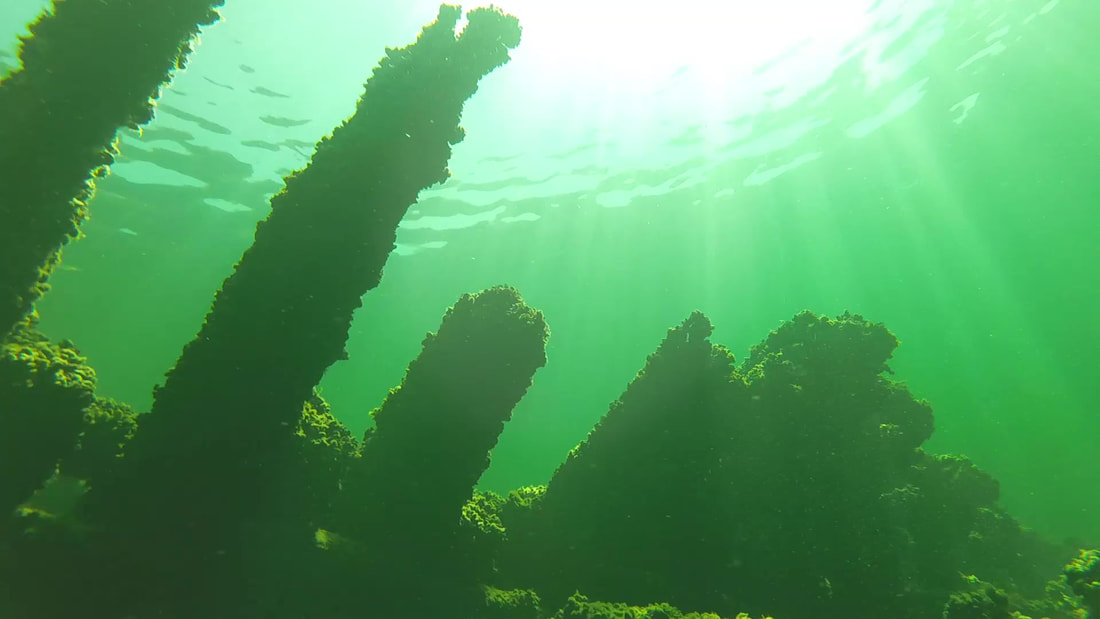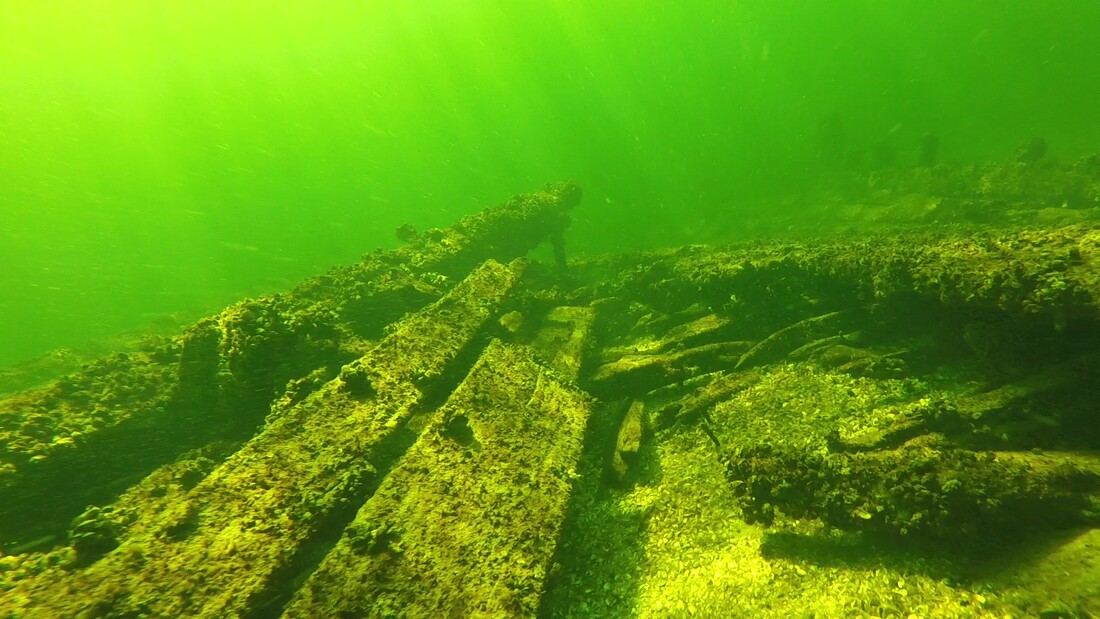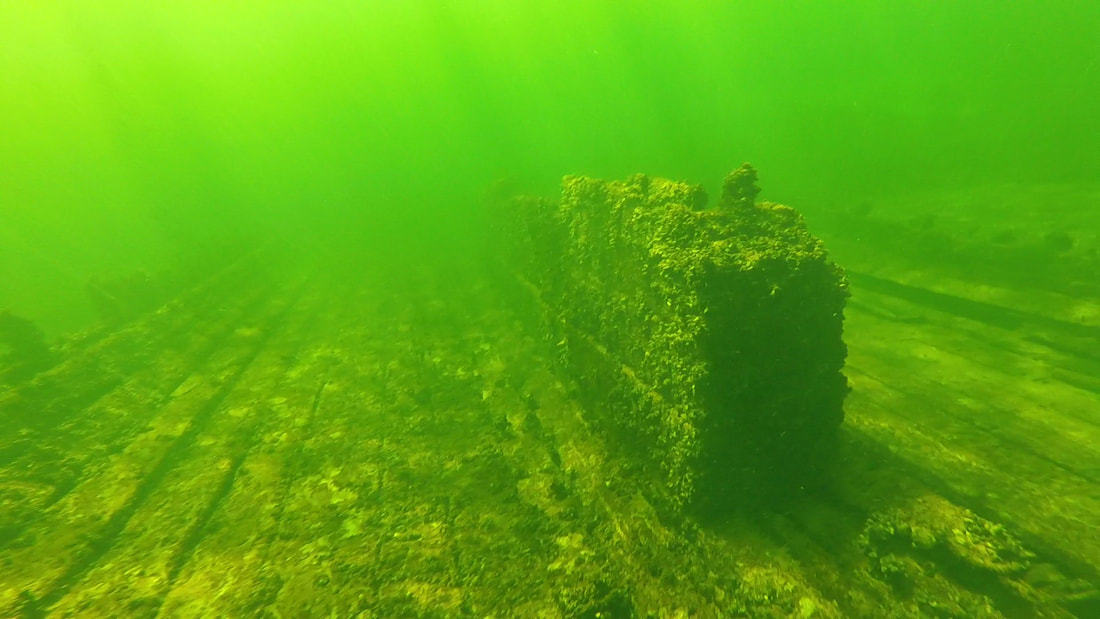|
Located in Washington Harbor at the north end of Washington Island is the final resting place of the 260 foot wood steam ship called the Louisiana. It was originally built in 1887 in Marine City, MI and it's design became a popular around the Great Lakes for hauling bulk cargo. Due to its efficiency 46 other boats were constructed like the Louisiana, including the R J Hackett which sank just a few miles away. It had a cargo hold that was 40 feet wide and 20 feet deep and the engine had a total of 610 horsepower. It had a long run on the Great Lakes for a boat during that time. In November of 1913 one of the worst storms in Great Lakes history took place shortly after the Louisiana dropped off a load of coal in Milwaukee, WI. The steam ship was making its way to Escanaba, MI to pick up iron ore and had just crossed Death's Door Passage when the storm struck. Seeking a safe refuge, the Louisiana dropped anchor in Washington Harbor. The anchor did not hold and the ship was beached on the east shore of the harbor. Perhaps the Louisiana could have been saved if that was all that happened but the next morning a fire broke out in the cargo hold dealing the final death blow to the Louisiana. In the years that followed, much of the ship was salvaged including the engine, propeller, and rudder. The ice eventually reduced the ship to its current state. Today the Louisiana is a great shipwreck to snorkel and free dive on since the ship gradually slopes down to 25 feet of water. Though the water in Washington Harbor is very cold, even in summer, it is some of the clearest you can find in Door County. It is not uncommon to have over 30 feet of visibility even in the middle of summer! The bottom of the hull is fairly well intact with large steel bolts sticking out of the ribs. Other pieces of metal are also scattered around the main wreck site. In the spring schools of baby fish can be spotted under the wreck and in summer bass also move into the wreckage and don't seem to be bothered by snorkelers. Zebra muscles, a small invasive mollusk, also cover much of the wreck. In early spring when the ice moves out the water is crystal clear even on the Green Bay side of the peninsula. This allows us to see some shipwrecks we can't later in the summer. One of these wrecks is the Hanover. The Hanover was a schooner originally built in 1853 and used as a bulk cargo ship that sailed through the Great Lakes. It was just over 100 feet long and was about 25 feet wide. In November of 1867 it was sailing up during a storm from Chicago to pick up lumber from Oconto, a small city on the other side of Green Bay. It ran aground just south of the Strawberry Islands on a small shoal that is sometimes visible when the water is low. The storm immediately began to break up the schooner and the captain ordered the crew to cut down the two masts and strip it of anything they could. The boat eventually settled in 27 feet of water. After the Hanover sank a strange thing happened. They ended up naming a different shoal after the wreck and not the actual shoal that sank the Hanover. No one is really sure why this happened. Is it because they forgot where the Hanover sank? Did they think the two shoals were connected? Did they just give it that name because it is much larger than the rock pile that sank the Hanover? The Hanover was certainly forgotten about and it wasn't until 2014 that the shipwreck was documented by archaeologists and added to the National Register of Historic Places. If this is the reason why a different shoal received the name they must have forgotten rather quickly where the Hanover actually sank. Though the water is cold in the spring it's still fun to free dive on this shipwreck when you can see it from the surface. I did a free dive on this wreck in 2015 and the entire bow section was visible but over the past few years sand, pebbles, and zebra muscle shells have started to cover the wreck. I've heard some years you can't even see the Hanover at all and as the lake levels lower and rise the wreck becomes covered and uncovered. The bow section was barely visible in 2019 but the stern and the rudder are completely clear of debris. In 2018 a sailboat stuck the same shoal that sank the Hanover. It didn't become a permanent shipwreck and was salvaged a few days later but I find it amazing that a shoal, or rock pile, that sank a boat over 150 years ago still manages to sink ships even today despite all of the modern navigation equipment mariners have at their disposal. The shipwreck of the Grapeshot must be one of my favorite shallow water shipwrecks in Door County. I know other people knew about it before me but it was one I didn't know about until I was bored one winter looking on Google Earth and saw the wooden beams spread out in the Plum Island Lagoon just a few hundred yards away from the old abandoned Coast Guard Station. I really couldn't wait to get out the following spring. When we finally launched the Gray Fox II it was the first place we went to. That year the water was low and when we drifted over the Grapeshot it was so close to the surface you could have nearly stuck your hand in the water to touch it. Since then it has been a regular sight on our Death's Door Tour and it never ceases to amaze me how well it has been preserved over all these years. The Grapeshot was originally built in 1855 in Buffalo, NY and used for hauling lumber, wheat, coal, and salt. In 1866 it ran aground near Plum Island and was salvaged and put back into service until November 1867 when it ran aground again, nearly in the same spot, on Plum Island. Salvage attempts were made again but it proved futile and eventually everything was removed from the Grapeshot including the cargo of lumber and the rigging. The ice continued to destroy the ship and scatter the remains of it around the lagoon. Today much of the wreck could very well be covered by sand but the main wreckage is sitting on top of limestone and protected from ice movement by the long sandbar the stretches to the northwest of Plum Island. Snorkeling over the Grapeshot is a lot of fun since so much of it is still intact and in fairly shallow water. The debris field of the wreck stretches over 60 feet and in the summer the lagoon warms up enough you don't really need a wetsuit. Small mouth bass swim in and out of the wreckage and in addition to the wooden beams there are steel bolts holding parts of the wreck together. It's not necessary to get in the water to see this wreck today and even with the high water we can always see it on our boat tour. |
Captain Matt OlsonBorn and raised in Door County, Matt always had an interest in local history, shipwrecks, and the natural wonders scattered around the peninsula. Now he has the opportunity to share his love of all things Door County with locals and visitors alike in the SHIP'S LOG. ArchivesCategories
All
|








 RSS Feed
RSS Feed